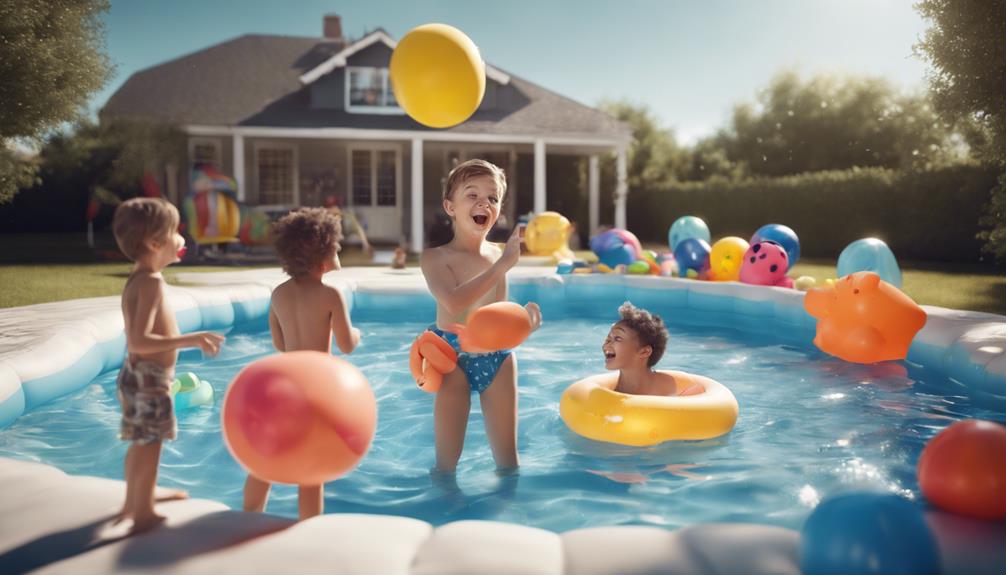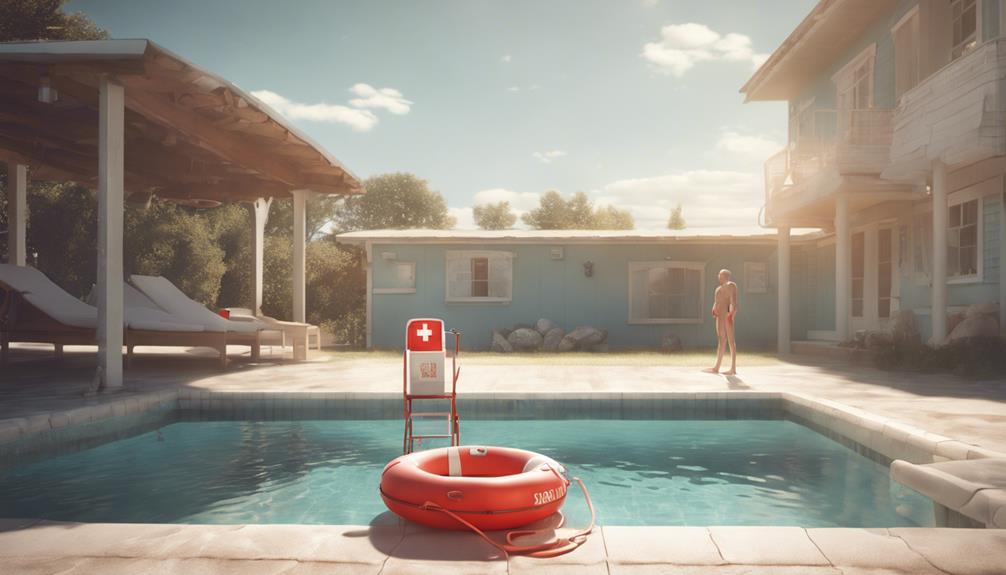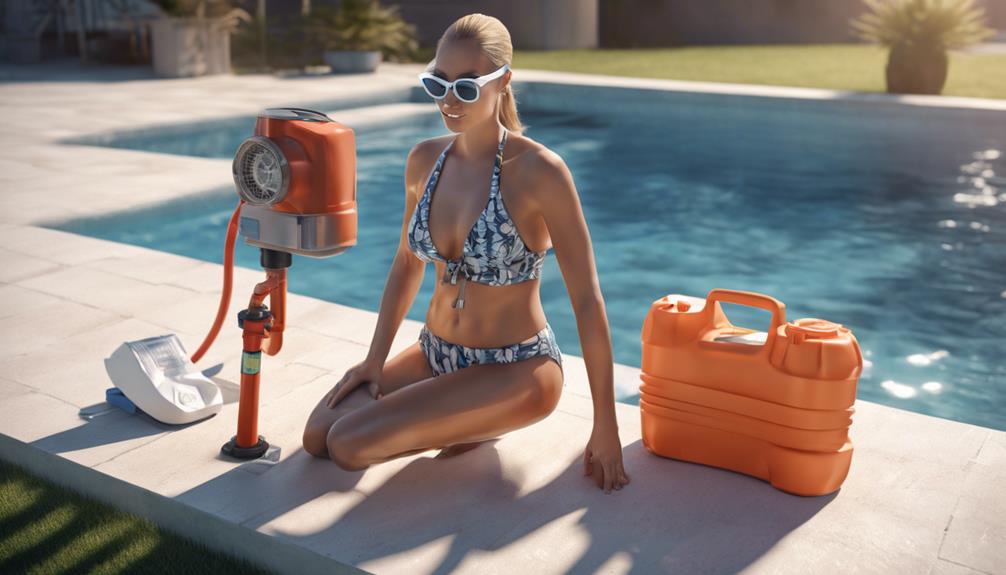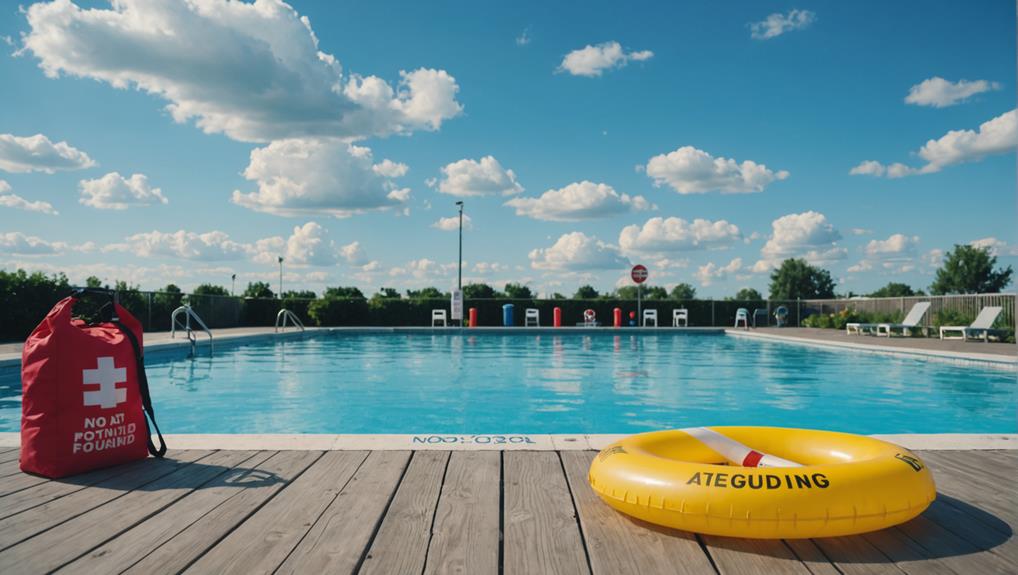When you jump into your backyard pool, you're entering a zone that demands strict safety measures to prevent accidents, injuries, and even fatalities. To stay safe, always swim with a buddy, as this reduces the risk of drowning by 90%. Prohibit diving in shallow water, and clearly mark no-diving areas to prevent severe head and spinal cord injuries. Constantly supervise children, avoiding distractions and knowing CPR and first aid. Steer clear of drains to prevent entrapment, and master pool emergency response techniques. Follow pool safety signs, and regularly inspect equipment to guarantee it meets safety standards. By following these essential rules, you'll be well on your way to a safe and enjoyable pool experience – and there's more to learn to certify a worry-free summer.
Key Takeaways
- Swim with a buddy to reduce the risk of drowning and promote mutual supervision and support.
- Prohibit diving in shallow water (less than 9 feet deep) to prevent severe head, neck, and spinal cord injuries.
- Maintain constant visual contact with children in the pool and designate a responsible adult to watch them.
- Avoid swimming near drains to prevent drain entrapment, especially if you have long hair or loose clothing.
- Learn basic first aid and CPR techniques, have a phone nearby, and know the emergency number to call in your area.
Swim With a Buddy Always
When you're swimming, having a buddy by your side is crucial, as it substantially reduces the risk of drowning and guarantees someone is available to call for help in case of an emergency.
In fact, swimming with a buddy reduces the risk of drowning by a staggering 90%.
The American Red Cross strongly recommends swimming with a buddy, especially for children and inexperienced swimmers, as it promotes water safety and encourages responsible swimming behaviors.
Having a buddy present allows for mutual supervision and support, enabling you to recognize signs of distress or fatigue and provide assistance if needed.
Additionally, a buddy can help prevent accidental falls into the pool, providing an extra pair of eyes to safeguard safe entry and exit from the pool area.
By swimming with a buddy, you're taking a critical step towards safeguarding your safety in and around the water.
No Diving in Shallow Water
Diving into shallow water can be a recipe for disaster, putting you at risk of severe head, neck, and spinal cord injuries that can lead to paralysis or even death. When you plunge into shallow water, you're not giving yourself enough room to safely enter the water, and the impact can be devastating.
To avoid such catastrophic injuries, taking the necessary precautions is vital to follow the safety rules and guidelines set by organizations like the American Red Cross.
Plunging should be prohibited in water less than 9 feet deep, and pool operators should clearly mark and enforce no-diving areas.
Plunging accidents are the leading cause of spinal cord injuries in the United States, with many of these accidents occurring in shallow water.
Between 2007 and 2016, an average of 6,400 Americans were treated in emergency rooms each year for plunging-related injuries, many of which occurred in shallow water.
Parents and caregivers should supervise children closely and teach them the importance of never plunging into shallow water.
Watch Children Closely Always

When you're supervising kids around the pool, it's vital that you're fully present and attentive.
You can't afford to get distracted by your phone, a book, or a conversation with someone else – your undivided attention is essential.
Supervise Without Distractions
As you're responsible for safeguarding the safety of children in the pool, it's essential to prioritize their oversight and eliminate any distractions that could compromise their well-being.
When supervising children, it's pivotal to maintain constant visual contact and be within arm's reach to respond quickly in case of an emergency.
To achieve this, follow these essential guidelines:
- Designate a responsible adult to watch children in the pool, guaranteeing they're within arm's reach and can respond quickly in case of an emergency.
- Avoid distractions such as using your phone, reading, or engaging in conversations, and instead maintain constant visual contact with children in the pool.
- Know CPR and first aid, and have a phone nearby in case of an emergency.
- Rotate supervising adults every 15-20 minutes to guarantee they remain alert and focused on the children in the pool.
Never Leave Unattended
By the pool, you must keep a hawk's eye on your children at all times, refusing to leave them unattended even for a split second.
Vital to stay within arm's reach of them, especially near the water's edge. A moment of distraction can be fatal, so put away your phone, avoid conversations, and don't let your attention waver.
Always prioritize your child's safety over everything else.
Never leave your children unattended near the pool, even if they know how to swim.
Drowning can occur silently, and imperative to respond quickly in case of an emergency.
Additionally, be aware of the pool's drains, as they can pose a significant hazard to kids.
Make sure they understand the dangers of swimming near drains and suction outlets.
Never Swim Near Drains
When you're swimming, it's vital that you're aware of your surroundings, especially when it comes to drains.
You should never swim near drains, as they can pose a significant threat to your safety.
Avoid Drain Entrapment
You must stay away from pool drains while swimming to avoid getting trapped, as the powerful suction can hold you underwater. This is a critical pool safety rule, as drain entrapment can lead to a serious risk of drowning.
To minimize this risk, make sure to:
- Always swim with a buddy who can help you in case of an emergency
- Avoid swimming near drains, especially if you have long hair or loose clothing that could get tangled
- Certify your pool has anti-entrapment drain covers, which are designed to prevent entrapment
- Check your pool's drain covers regularly to guarantee they're secure and functioning properly
Stay Away From Suction
Never venture near pool drains while swimming, as the intense suction force can swiftly pull you down, making it difficult to break free. This is a vital pool safety rule to remember, as the suction can be powerful enough to trap you underwater.
To avoid such a scenario, you should always stay away from drains and suction outlets when swimming. Make sure to educate yourself and others, especially children, about the perils of swimming near drains.
Additionally, verify that your pool is equipped with the necessary safety equipment, such as drain covers and anti-entrapment devices, to prevent accidents.
It's also essential to have access to water rescue equipment, like a rescue tube or a shepherd's hook, in case of an emergency.
Learn Pool Emergency Response

Every pool owner should have a clear plan in place for responding to emergencies, as prompt action can mean the difference between life and death. You never know when a pool accident might occur, but being prepared can help prevent tragedies.
Crucial to master is learning pool emergency response techniques and having a plan in place for common pool emergencies.
Some vital lessons to learn include:
- Knowing what to do if a child is missing, such as immediately calling for help and checking the pool first
- Understanding basic first aid and CPR techniques
- Having a phone nearby and knowing the emergency number to call in your area
- Posting pool safety rules and following safety steps to prevent accidents from happening in the first place
Follow Pool Safety Signs
One pivotal aspect of pool safety is paying attention to the safety signs posted around the pool area, as they provide essential information and warnings to help prevent accidents.
You should always make it a habit to read and follow the instructions on these signs, as they're designed to keep you and others safe.
For instance, pool safety signs may indicate the depth of the pool, warn of slippery surfaces, or provide key pool safety tips.
Additionally, you should verify that your pool area is equipped with a self-latching gate that's at least 4 feet tall to prevent unauthorized access, especially for young children and pets.
Make sure the gate is locked when the pool isn't in use, and that it's well-maintained to prevent any malfunctions.
Inspect Pool Equipment Regularly

You play a pivotal role in preventing pool accidents and injuries by regularly inspecting your pool equipment to guarantee it's functioning properly and safely. This is a key aspect of pool safety rules, as faulty equipment can lead to electrical shocks, fires, or other hazards.
Check pool equipment for signs of wear and tear, corrosion, or damage, and replace or repair them as needed to maintain pool safety.
Make sure all pool equipment is well-maintained and clean to prevent mechanical failures that can lead to electrical shocks, fires, or other hazards.
Inspect pool equipment regularly to verify it meets safety standards and guidelines, such as those set by the Consumer Product Safety Commission (CPSC) and the American Society for Testing and Materials (ASTM).
Keep a record of pool equipment inspections and maintenance to track any issues, repairs, or replacements, and to verify compliance with safety regulations and guidelines.
Frequently Asked Questions
What Are Some Pool Safety Rules?
When you're a pool-owner, you must guarantee safety first; you're responsible for installing pool fencing at least 4 feet high with secure gate latches, covering the pool when not in use, and having emergency phones nearby.
What Are the Safety Rules in Swimming?
When you're swimming, you must follow safety rules to prevent pool accidents and water emergencies. Guarantee swim supervision, practice drowning prevention, and know lifeguard duties to minimize risks and certify a safe aquatic experience.
What Are the Rules for Water Safety?
As you venture into the watery domain, remember that ancient civilizations revered water as a sacred entity; now, you must prioritize water safety by ensuring poolside supervision, being aware of waterborne pathogens, and understanding drowning prevention strategies to mitigate aquatic hazards, all backed by rigorous lifeguard training.
What Are the 5 Safety Precautions When You Are Swimming in an Open Sea Area?
When you're swimming in an open sea area, you're responsible for monitoring sea conditions, respecting marine life, checking water clarity, avoiding rip currents, and being aware of the ocean floor's terrain to guarantee a safe and enjoyable experience.
Conclusion
You've made it to the end of this essential guide to swimming pool safety rules.
By following these 7 critical rules, you'll substantially diminish the risk of accidents and guarantee a fun, safe experience for everyone.
Drowning is the leading cause of unintentional injury death worldwide, accounting for 7% of all injury-related deaths, according to the Centers for Disease Control and Prevention.
Stay vigilant, and let's make our pools safer!

I’m Max, the founder and chief pool enthusiast behind Pool Pro Tips. As a passionate pool owner and cleaning expert, I created this website to share my knowledge and experience with you, helping you to keep your pool sparkling clean and safe for years to come.

